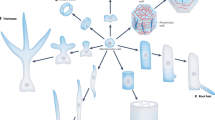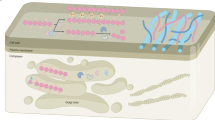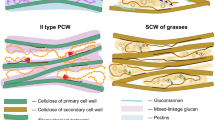Abstract
The bulk of a plant’s biomass, termed secondary cell walls, accumulates in woody xylem tissues and is largely recalcitrant to biochemical degradation and saccharification1. By contrast, primary cell walls, which are chemically distinct, flexible and generally unlignified2, are easier to deconstruct. Thus, engineering certain primary wall characteristics into xylem secondary walls would be interesting to readily exploit biomass for industrial processing. Here, we demonstrated that by expressing AP2/ERF transcription factors from group IIId and IIIe in xylem fibre cells of mutants lacking secondary walls, we could generate plants with thickened cell wall characteristics of primary cell walls in the place of secondary cell walls. These unique, newly formed walls displayed physicochemical and ultrastructural features consistent with primary walls and had gene expression profiles illustrative of primary wall synthesis. These data indicate that the group IIId and IIIe AP2/ERFs are transcription factors regulating primary cell wall deposition and could form the foundation for exchanging one cell wall type for another in plants.
This is a preview of subscription content, access via your institution
Access options
Access Nature and 54 other Nature Portfolio journals
Get Nature+, our best-value online-access subscription
$29.99 / 30 days
cancel any time
Subscribe to this journal
Receive 12 digital issues and online access to articles
$119.00 per year
only $9.92 per issue
Buy this article
- Purchase on Springer Link
- Instant access to full article PDF
Prices may be subject to local taxes which are calculated during checkout




Similar content being viewed by others
Data availability
The microarray data in this study were deposited to the NCBI GEO under the accession number GSE81039. Other data that support the findings of this study are available from the corresponding author upon reasonable request. Figures 1l–o, 2b,d and 3a,b,d–f and Supplementary Figs. 3, 4, 7c, 10, 11, 14–18, 21 and 22 have associated raw data.
References
Harris, D. & DeBolt, S. Synthesis, regulation and utilization of lignocellulosic biomass. Plant Biotechnol. J. 8, 244–262 (2010).
Cosgrove, D. J. Re-constructing our models of cellulose and primary cell wall assembly. Curr. Opin. Plant Biol. 22, 122–131 (2014).
Wang, T., McFarlane, H. E. & Persson, S. The impact of abiotic factors on cellulose synthesis. J. Exp. Bot. 67, 543–552 (2016).
Albersheim, P., Darvill, A., Roberts, K., Sederoff, R. & Staehelin, A. Plant Cell Walls: From Chemistry to Biology (Garland Science, New York, 2010).
Kumar, M., Campbell, L. & Turner, S. Secondary cell walls: biosynthesis and manipulation. J. Exp. Bot. 67, 515–531 (2016).
Phitsuwan, P., Sakka, K. & Ratanakhanokchai, K. Improvement of lignocellulosic biomass in planta: a review of feedstocks, biomass recalcitrance, and strategic manipulation of ideal plants designed for ethanol production and processability. Biomass Bioenergy 58, 390–405 (2013).
Mottiar, Y., Vanholme, R., Boerjan, W., Ralph, J. & Mansfield, S. D. Designer lignins: harnessing the plasticity of lignification. Curr. Opin. Biotechnol. 37, 190–200 (2016).
Engels, F. M. & Jung, H. G. Alfalfa stem tissues: cell-wall development and lignification. Annals Bot. 82, 561–568 (1998).
Müller, S. et al. Cell wall composition of vascular and parenchyma tissues in broccoli stems. J. Sci. Food. Agric. 83, 1289–1292 (2003).
Wilson, W. D., Jarvis, M. C. & Duncan, H. J. In-vitro digestibility of kale (Brassica oleracea) secondary xylem and parenchyma cell walls and their polysaccharide components. J. Sci. Food. Agric. 48, 9–14 (1989).
Brereton, N. J. B. et al. Reaction wood—a key cause of variation in cell wall recalcitrance in willow. Biotech. Biofuels 5, 83 (2012).
Mitsuda, N. et al. NAC transcription factors, NST1 and NST3, are key regulators of the formation of secondary walls in woody tissues of Arabidopsis. Plant Cell 19, 270–280 (2007).
Nakano, T., Suzuki, K., Fujimura, T. & Shinshi, H. Genome-wide analysis of the ERF gene family in Arabidopsis and rice. Plant Physiol. 140, 411–432 (2006).
Wilson, K., Long, D., Swinburne, J. & Coupland, G. A dissociation insertion causes a semidominant mutation that increases expression of TINY, an Arabidopsis gene related to APETALA2. Plant Cell 8, 659–671 (1996).
O’Malley, R. C. et al. Cistrome and epicistrome features shape the regulatory DNA landscape. Cell 165, 1280–1292 (2016).
Gaudinier, A. et al. Enhanced Y1H assays for Arabidopsis. Nat. Methods 8, 1053–1055 (2011).
Nagata, T. & Takebe, I. Cell wall regeneration and cell division in isolated tobacco mesophyll protoplasts. Planta 92, 301–308 (1970).
Hiratsu, K., Matsui, K., Koyama, T. & Ohme-Takagi, M. Dominant repression of target genes by chimeric repressors that include the EAR motif, a repression domain, in Arabidopsis. Plant J. 34, 733–739 (2003).
Kang, J. S. et al. Salt tolerance of Arabidopsis thaliana requires maturation of N-glycosylated proteins in the Golgi apparatus. Proc. Natl Acad. Sci. USA 105, 5933–5938 (2008).
Scheible, W. R., Eshed, R., Richmond, T., Delmer, D. & Somerville, C. Modifications of cellulose synthase confer resistance to isoxaben and thiazolidinone herbicides in Arabidopsis Ixr1 mutants. Proc. Natl Acad. Sci. USA 98, 10079–10084 (2001).
Lasserre, E., Jobet, E., Llauro, C. & Delseny, M. AtERF38 (At2g35700), an AP2/ERF family transcription factor gene from Arabidopsis thaliana, is expressed in specific cell types of roots, stems and seeds that undergo suberization. Plant Physiol. Biochem. 46, 1051–1061 (2008).
Sakamoto, S. & Mitsuda, N. Reconstitution of a secondary cell wall in a secondary cell wall-deficient Arabidopsis mutant. Plant Cell Physiol. 56, 299–310 (2015).
Pattathil, S. et al. A comprehensive toolkit of plant cell wall glycan-directed monoclonal antibodies. Plant Physiol. 153, 514–525 (2010).
Knox, J. P., Linstead, P. J., King, J., Cooper, C. & Roberts, K. Pectin esterification is spatially regulated both within cell walls and between developing tissues of root apices. Planta 181, 512–521 (1990).
Jones, L., Seymour, G. B. & Knox, J. P. Localization of pectic galactan in tomato cell walls using a monoclonal antibody specific to (1→4)-β-d-galactan. Plant Physiol. 113, 1405–1412 (1997).
Willats, W. G., Marcus, S. E. & Knox, J. P. Generation of a monoclonal antibody specific to (1→5)-α-l-arabinan. Carbohydr. Res. 308, 149–152 (1998).
McCartney, L., Marcus, S. E. & Knox, J. P. Monoclonal antibodies to plant cell wall xylans and arabinoxylans. J. Histochem. Cytochem. 53, 543–546 (2005).
Blake, A. W. et al. Understanding the biological rationale for the diversity of cellulose-directed carbohydrate-binding modules in prokaryotic enzymes. J. Biol. Chem. 281, 29321–29329 (2006).
Anderson, C. T., Carroll, A., Akhmetova, L. & Somerville, C. Real-time imaging of cellulose reorientation during cell wall expansion in Arabidopsis roots. Plant Physiol. 152, 787–796 (2010).
Mitra, P. P. & Loqué, D. Histochemical staining of Arabidopsis thaliana secondary cell wall elements. J. Vis. Exp. 87, 51381 (2014).
Zeng, Y., Zhao, S., Yang, S. & Ding, S. Y. Lignin plays a negative role in the biochemical process for producing lignocellulosic biofuels. Curr. Opin. Biotechnol. 27, 38–45 (2014).
Stewart, J. J., Akiyama, T., Chapple, C., Ralph, J. & Mansfield, S. D. The effects on lignin structure of overexpression of ferulate 5-hydroxylase in hybrid poplar. Plant Physiol. 150, 621–635 (2009).
Vanholme, R. et al. Caffeoyl shikimate esterase (CSE) is an enzyme in the lignin biosynthetic pathway in Arabidopsis. Science 341, 1103–1106 (2013).
Wilkerson, C. G. et al. Monolignol ferulate transferase introduces chemically labile linkages into the lignin backbone. Science 344, 90–93 (2014).
Sakamoto, S. et al. Wood reinforcement of poplar by rice NAC transcription factor. Sci. Rep. 6, 19925 (2016).
Storey, J. D. & Tibshirani, R. Statistical significance for genome wide studies. Proc. Natl Acad. Sci. USA 100, 9440–9445 (2003).
Kumar, S., Stecher, G., Li, M., Knyaz, C. & Tamura, K. MEGA X: molecular evolutionary genetics analysis across computing platforms. Mol. Biol. Evol. 35, 1547–1549 (2018).
Acknowledgements
We thank A. Hosaka, A. Kuwazawa, F. Tobe, M. Yamada, Y. Sugimoto and Y. Takiguchi for their technical support. This work was supported by the JST ALCA program (grant no. JPMJAL1107) (to N.M.), a postdoctoral fellowship from the German Research Foundation (DFG, project 344523413) (to M.S.), University of Melbourne R@MAP Professorship, an ARC Future Fellowship grant (FT160100218) and a UoM IRRTF RNC grant (501892) (to S.P.) and an NSERC Discovery Grant (to S.D.M.).
Author information
Authors and Affiliations
Contributions
N.M. conceived and executed the project as principal investigator. N.M. and S.S. designed the experimental plans. K.Y. performed the tensile test and microarray data analysis. S.P. and S.D.M. designed the experiment related to CoMPP and cellulose analyses. S.S. performed all of the experiments except for CoMPP, cellulose analyses, TEM imaging and the yeast one-hybrid assay. M.S. performed the CoMPP analysis with the supervision of S.P. M.T.N. observed the root of the 35Spro::ERF035 plant. F.U. and S.D.M. performed the cellulose analyses. T.W., A.-M.B. and A.G. performed the yeast one-hybrid assay and its preparation. S.M.B. and S.P. designed and supervised the yeast one-hybrid assay. K.A. and Y.K. performed the TEM imaging, preparation of the thin section and the analysis of images. S.S., S.P. and N.M. mainly wrote the manuscript, with all other authors contributing to revisions.
Corresponding author
Ethics declarations
Competing interests
The authors declare no competing interests.
Additional information
Publisher’s note: Springer Nature remains neutral with regard to jurisdictional claims in published maps and institutional affiliations.
Supplementary information
Supplementary Information
Supplementary Methods, Supplementary References and Supplementary Figures 1–25.
Supplementary Table 1
Over-represented cell-wall-related GO terms in up-regulated genes in nst1 nst3 NST3pro:ERF035-VP16 plants.
Supplementary Table 2
Fold changes of cell wall-related genes in NST3p:ERF035-VP16 nst1 nst3 as per nst1 nst3.
Supplementary Table 3
Fold changes of cell wall-related genes in NST3p:ERF035-VP16 nst1 nst3 as per nst1 nst3 and in wt as per nst1 nst3.
Supplementary Table 4
List of upregulated genes related to cell wall biosynthesis in the nst1 nst3 NST3pro:ERF035-VP16 transgenic plants.
Supplementary Table 5
Over-represented cell-wall-related GO terms in putative target genes of group IIId and IIIe ERFs.
Supplementary Table 6
Primers in this study.
Supplementary Table 7
All transcription factor genes focused in this study.
Supplementary Table 8
Amino acid sequences of conserved domain used for constructing phylogenetic tree shown in Supplementary Fig. 25.
Rights and permissions
About this article
Cite this article
Sakamoto, S., Somssich, M., Nakata, M.T. et al. Complete substitution of a secondary cell wall with a primary cell wall in Arabidopsis. Nature Plants 4, 777–783 (2018). https://doi.org/10.1038/s41477-018-0260-4
Received:
Accepted:
Published:
Issue Date:
DOI: https://doi.org/10.1038/s41477-018-0260-4
This article is cited by
-
Promoter variations of ClERF1 gene determines flesh firmness in watermelon
BMC Plant Biology (2024)
-
Contributions of lignification, tissue arrangement patterns, and cross-sectional area to whole-stem mechanical properties in Arabidopsis thaliana
Journal of Plant Research (2024)
-
The cotton pectin methyl esterase gene GhPME21 functions in microspore development and fertility in Gossypium hirsutum L.
Plant Molecular Biology (2023)
-
Cell wall integrity regulation across plant species
Plant Molecular Biology (2022)
-
In silico analysis of key regulatory networks related to microfibril angle in Populus trichocarpa Hook.
Biologia (2022)



